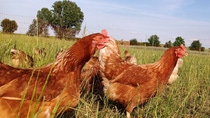Media
BASF offers an alternative to formaldehyde in animal-feed hygiene enhancement

One of meat producers’ greatest priorities is food safety – making sure that the feed their livestock consumes keeps them healthy during the whole life cycle process – so that it is later safe to be ingested by humans. The food the animals consume can affect their likelihood to get sick, contract salmonella, E. coli or any other dangerous bacteria, which could eventually force that beef, poultry or pork to be thrown out and food to go to waste.
To prevent this kind of contamination from happening, feed producers often turn to preservatives such as organic acids or formaldehyde.
While formaldehyde is an effective means in reducing salmonella contamination in feed – it comes with a drawback – it was classified as a probable human carcinogen by the EPA in 1987.
While classification of formaldehyde as a probable human carcinogen does not mean that the material cannot be used safely, it does convey that additional care and consideration are necessary for safe use and these additional precautions may come with an added cost. Also, when it comes to the regulatory environment, most recently the EU commission has chosen not to reauthorize formaldehyde for use as a feed additive. This ban on formaldehyde leaves formic acid as the lone remaining ingredient in the recently added “feed hygiene enhancer” functional category in Europe as of January 2018.
Formic acid, an FDA-approved feed acidifier, has consistently shown to be one of the most potent organic acids for killing potential feed microbial contaminants such as salmonella, E.coli, clostridia and campylobacter, according to two separate research articles (G. Strauss and Ruth Hayler; Maria A. Navarro et al.).
For this reason, an alternative exists when it comes to the treatment of feedstuffs. That substitute is a formic acid called Amasil. Produced by BASF, Amasil supports vital animal performance through optimal feed hygiene, and controls pathogens, such as salmonella, without the safety concerns.
“Amasil is an ingredient that can be used to alter pH of feed and drinking water for livestock,” said Joshua Jendza, Technical Product Manager, Organic Acids & Novasil, BASF North America. “Its primary advantage is that it is based on formic acid; it makes it possible to reach pH targets that you can’t meet with other organic acids.”
The importance of acidification in animal feed is not to be underestimated. Due to limited gastric hydrochloric acid production, some animals such as piglets are unable to digest feed properly. Acidification of piglet feed lowers the pH of the feed and reduces the buffering capacity. This allows the piglet, even with limited gastric acid production, to digest the feed in its stomach in an optimal manner and make full use of its nutrients. Reduced pH in feed can lead to better acidification of the gut, greater activity of endogenous and exogenous enzymes, and an overall improvement in feed efficiency and nutrient availability (Blanke et al., 2012 & 2013).

BASF’s feed additives also help poultry, such as laying hens and broilers, to make better use of the energy in their feed. Also, food handling is safer with a formic acid.
“Customers buy this product because it works better than other organic acids,” Jendza added. “It is overall a safer alternative to formaldehyde.”
Summed up, the benefits of using Amasil in animal feed are the following:
- Best-in-class feed and water acidifier
- Inhibits harmful enteral bacteria through the antimicrobial effect of formic acid and its superior acidification
- Improves digestibility of compound feed for better feed conversion and vitality
- As a buffered mixture, Amasil NA maintains carbon steel infrastructure longer with less corrosiveness
BASF’s long-term customer – Coren – one of the largest agro-food cooperatives in Spain that produces poultry, pork and beef, is highly fond of using formic acid in its animal feed.
“Amasil is an important ingredient that complements other measures we use to control pathogens, such as salmonella,” said Jesus Mendez Batan, Chief of Nutrition & Research Department, Coren. “The formic acid enables us to maintain hygiene in the facilities. It is also easy and safe to handle. Additionally, it gave us the opportunity to reduce the amount of salt in the diets for egg production.”
To learn more about BASF-produced formic acid solutions Amasil and Amasil NA, click here.
Published on Sept. 8, 2020, by Anna Spiewak.
For media inquiries or to repurpose this article, please contact Lisa Brown.
